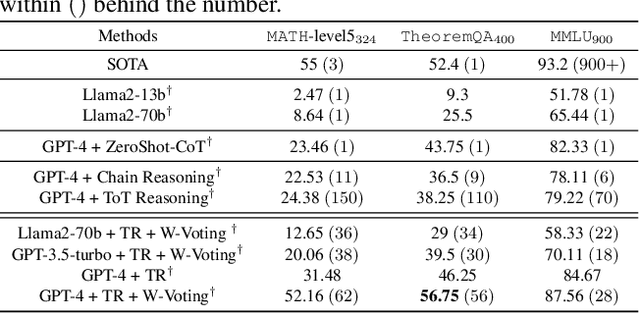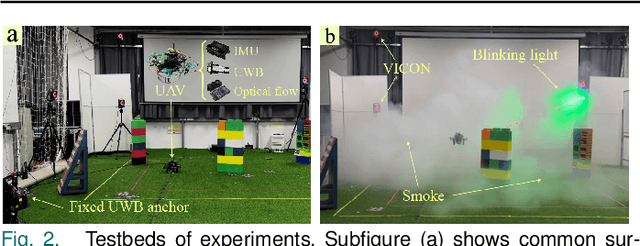Sijia Chen
Shanghai Jiaotong University
Fast and Simplex: 2-Simplicial Attention in Triton
Jul 03, 2025Abstract:Recent work has shown that training loss scales as a power law with both model size and the number of tokens, and that achieving compute-optimal models requires scaling model size and token count together. However, these scaling laws assume an infinite supply of data and apply primarily in compute-bound settings. As modern large language models increasingly rely on massive internet-scale datasets, the assumption that they are compute-bound is becoming less valid. This shift highlights the need for architectures that prioritize token efficiency. In this work, we investigate the use of the 2-simplicial Transformer, an architecture that generalizes standard dot-product attention to trilinear functions through an efficient Triton kernel implementation. We demonstrate that the 2-simplicial Transformer achieves better token efficiency than standard Transformers: for a fixed token budget, similarly sized models outperform their dot-product counterparts on tasks involving mathematics, coding, reasoning, and logic. We quantify these gains by demonstrating that $2$-simplicial attention changes the exponent in the scaling laws for knowledge and reasoning tasks compared to dot product attention.
ReaMOT: A Benchmark and Framework for Reasoning-based Multi-Object Tracking
May 26, 2025Abstract:Referring Multi-object tracking (RMOT) is an important research field in computer vision. Its task form is to guide the models to track the objects that conform to the language instruction. However, the RMOT task commonly requires clear language instructions, such methods often fail to work when complex language instructions with reasoning characteristics appear. In this work, we propose a new task, called Reasoning-based Multi-Object Tracking (ReaMOT). ReaMOT is a more challenging task that requires accurate reasoning about objects that match the language instruction with reasoning characteristic and tracking the objects' trajectories. To advance the ReaMOT task and evaluate the reasoning capabilities of tracking models, we construct ReaMOT Challenge, a reasoning-based multi-object tracking benchmark built upon 12 datasets. Specifically, it comprises 1,156 language instructions with reasoning characteristic, 423,359 image-language pairs, and 869 diverse scenes, which is divided into three levels of reasoning difficulty. In addition, we propose a set of evaluation metrics tailored for the ReaMOT task. Furthermore, we propose ReaTrack, a training-free framework for reasoning-based multi-object tracking based on large vision-language models (LVLM) and SAM2, as a baseline for the ReaMOT task. Extensive experiments on the ReaMOT Challenge benchmark demonstrate the effectiveness of our ReaTrack framework.
CARES: Comprehensive Evaluation of Safety and Adversarial Robustness in Medical LLMs
May 16, 2025Abstract:Large language models (LLMs) are increasingly deployed in medical contexts, raising critical concerns about safety, alignment, and susceptibility to adversarial manipulation. While prior benchmarks assess model refusal capabilities for harmful prompts, they often lack clinical specificity, graded harmfulness levels, and coverage of jailbreak-style attacks. We introduce CARES (Clinical Adversarial Robustness and Evaluation of Safety), a benchmark for evaluating LLM safety in healthcare. CARES includes over 18,000 prompts spanning eight medical safety principles, four harm levels, and four prompting styles: direct, indirect, obfuscated, and role-play, to simulate both malicious and benign use cases. We propose a three-way response evaluation protocol (Accept, Caution, Refuse) and a fine-grained Safety Score metric to assess model behavior. Our analysis reveals that many state-of-the-art LLMs remain vulnerable to jailbreaks that subtly rephrase harmful prompts, while also over-refusing safe but atypically phrased queries. Finally, we propose a mitigation strategy using a lightweight classifier to detect jailbreak attempts and steer models toward safer behavior via reminder-based conditioning. CARES provides a rigorous framework for testing and improving medical LLM safety under adversarial and ambiguous conditions.
OVTR: End-to-End Open-Vocabulary Multiple Object Tracking with Transformer
Mar 13, 2025



Abstract:Open-vocabulary multiple object tracking aims to generalize trackers to unseen categories during training, enabling their application across a variety of real-world scenarios. However, the existing open-vocabulary tracker is constrained by its framework structure, isolated frame-level perception, and insufficient modal interactions, which hinder its performance in open-vocabulary classification and tracking. In this paper, we propose OVTR (End-to-End Open-Vocabulary Multiple Object Tracking with TRansformer), the first end-to-end open-vocabulary tracker that models motion, appearance, and category simultaneously. To achieve stable classification and continuous tracking, we design the CIP (Category Information Propagation) strategy, which establishes multiple high-level category information priors for subsequent frames. Additionally, we introduce a dual-branch structure for generalization capability and deep multimodal interaction, and incorporate protective strategies in the decoder to enhance performance. Experimental results show that our method surpasses previous trackers on the open-vocabulary MOT benchmark while also achieving faster inference speeds and significantly reducing preprocessing requirements. Moreover, the experiment transferring the model to another dataset demonstrates its strong adaptability. Models and code are released at https://github.com/jinyanglii/OVTR.
ParetoQ: Scaling Laws in Extremely Low-bit LLM Quantization
Feb 04, 2025Abstract:The optimal bit-width for achieving the best trade-off between quantized model size and accuracy has been a subject of ongoing debate. While some advocate for 4-bit quantization, others propose that 1.58-bit offers superior results. However, the lack of a cohesive framework for different bits has left such conclusions relatively tenuous. We present ParetoQ, the first unified framework that facilitates rigorous comparisons across 1-bit, 1.58-bit, 2-bit, 3-bit, and 4-bit quantization settings. Our findings reveal a notable learning transition between 2 and 3 bits: For 3-bits and above, the fine-tuned models stay close to their original pre-trained distributions, whereas for learning 2-bit networks or below, the representations change drastically. By optimizing training schemes and refining quantization functions, ParetoQ surpasses all previous methods tailored to specific bit widths. Remarkably, our ParetoQ ternary 600M-parameter model even outperforms the previous SoTA ternary 3B-parameter model in accuracy, using only one-fifth of the parameters. Extensive experimentation shows that ternary, 2-bit, and 3-bit quantization maintains comparable performance in the size-accuracy trade-off and generally exceeds 4-bit and binary quantization. Considering hardware constraints, 2-bit quantization offers promising potential for memory reduction and speedup.
Calibre: Towards Fair and Accurate Personalized Federated Learning with Self-Supervised Learning
Dec 28, 2024



Abstract:In the context of personalized federated learning, existing approaches train a global model to extract transferable representations, based on which any client could train personalized models with a limited number of data samples. Self-supervised learning is considered a promising direction as the global model it produces is generic and facilitates personalization for all clients fairly. However, when data is heterogeneous across clients, the global model trained using SSL is unable to learn high-quality personalized models. In this paper, we show that when the global model is trained with SSL without modifications, its produced representations have fuzzy class boundaries. As a result, personalized learning within each client produces models with low accuracy. In order to improve SSL towards better accuracy without sacrificing its advantage in fairness, we propose Calibre, a new personalized federated learning framework designed to calibrate SSL representations by maintaining a suitable balance between more generic and more client-specific representations. Calibre is designed based on theoretically-sound properties, and introduces (1) a client-specific prototype loss as an auxiliary training objective; and (2) an aggregation algorithm guided by such prototypes across clients. Our experimental results in an extensive array of non-i.i.d.~settings show that Calibre achieves state-of-the-art performance in terms of both mean accuracy and fairness across clients. Code repo: https://github.com/TL-System/plato/tree/main/examples/ssl/calibre.
Toward Adaptive Reasoning in Large Language Models with Thought Rollback
Dec 27, 2024



Abstract:Large language models (LLMs) have been routinely used to solve various tasks using step-by-step reasoning. However, the structure of intermediate reasoning steps, or thoughts, is rigid and unidirectional, such as chains, trees, or acyclic-directed graphs. Consequently, the resulting inflexible and forward-only reasoning may not address challenging tasks and fail when the LLM frequently gives false responses, i.e., ``hallucinations''. This paper proposes a new reasoning framework, called Thought Rollback (TR), allowing LLMs to adaptively build thought structure while maintaining effective reasoning toward problem-solving under ``hallucinations''. The core mechanism of TR is rolling back thoughts, which allows LLMs to perform error analysis on thoughts, and thus roll back to any previously mistaken thought for revision. Subsequently, by including such trial-and-error in the prompt to guide the LLM, each rollback leads to one more reliable reasoning path. Therefore, starting with a simple prompt without human annotations, LLM with TR adaptively and gradually explores thoughts for a correct solution. Comprehensive experiments on mathematical problems and multi-task reasoning demonstrate the state-of-the-art performance of TR in terms of problem-solving rate and interaction cost. For instance, the solving rate of GPT-4 with TR outperforms the current best by $9\%$ on the MATH dataset.
Cross-View Referring Multi-Object Tracking
Dec 23, 2024Abstract:Referring Multi-Object Tracking (RMOT) is an important topic in the current tracking field. Its task form is to guide the tracker to track objects that match the language description. Current research mainly focuses on referring multi-object tracking under single-view, which refers to a view sequence or multiple unrelated view sequences. However, in the single-view, some appearances of objects are easily invisible, resulting in incorrect matching of objects with the language description. In this work, we propose a new task, called Cross-view Referring Multi-Object Tracking (CRMOT). It introduces the cross-view to obtain the appearances of objects from multiple views, avoiding the problem of the invisible appearances of objects in RMOT task. CRMOT is a more challenging task of accurately tracking the objects that match the language description and maintaining the identity consistency of objects in each cross-view. To advance CRMOT task, we construct a cross-view referring multi-object tracking benchmark based on CAMPUS and DIVOTrack datasets, named CRTrack. Specifically, it provides 13 different scenes and 221 language descriptions. Furthermore, we propose an end-to-end cross-view referring multi-object tracking method, named CRTracker. Extensive experiments on the CRTrack benchmark verify the effectiveness of our method. The dataset and code are available at https://github.com/chen-si-jia/CRMOT.
HadaCore: Tensor Core Accelerated Hadamard Transform Kernel
Dec 12, 2024Abstract:We present HadaCore, a modified Fast Walsh-Hadamard Transform (FWHT) algorithm optimized for the Tensor Cores present in modern GPU hardware. HadaCore follows the recursive structure of the original FWHT algorithm, achieving the same asymptotic runtime complexity but leveraging a hardware-aware work decomposition that benefits from Tensor Core acceleration. This reduces bottlenecks from compute and data exchange. On Nvidia A100 and H100 GPUs, HadaCore achieves speedups of 1.1-1.4x and 1.0-1.3x, with a peak gain of 3.5x and 3.6x respectively, when compared to the existing state-of-the-art implementation of the original algorithm. We also show that when using FP16 or BF16, our implementation is numerically accurate, enabling comparable accuracy on MMLU benchmarks when used in an end-to-end Llama3 inference run with quantized (FP8) attention.
A Novel Ternary Evolving Estimator for Positioning Unmanned Aerial Vehicle in Harsh Environments
Sep 10, 2024



Abstract:Obtaining reliable position estimation is fundamental for unmanned aerial vehicles during mission execution, especially in harsh environments. But environmental interference and abrupt changes usually degrade measurement reliability, leading to estimation divergence. To address this, existing works explore adaptive adjustment of sensor confidence. Unfortunately, existing methods typically lack synchronous evaluation of estimation precision, thereby rendering adjustments sensitive to abnormal data and susceptible to divergence. To tackle this issue, we propose a novel ternary-channel adaptive evolving estimator equipped with an online error monitor, where the ternary channels, states, noise covariance matrices and especially aerial drag, evolve simultaneously with environment. Firstly, an augmented filter is employed to pre-processes multidimensional data, followed by an inverse-Wishart smoother utilized to obtain posterior states and covariance matrices. Error propagation relation during estimation is analysed and hence an indicator is devised for online monitoring estimation errors. Under this premise, several restrictions are applied to suppress potential divergence led by interference. Additionally, considering motion dynamics, aerial drag matrix is reformulated based on updated states and covariance matrices. Finally, the observability, numerical sensitivity and arithmetic complexity of the proposed estimator are mathematically analyzed. Extensive experiments are conducted in both common and harsh environments (with average RMSE 0.17m and 0.39m respectively) to verify adaptability of algorithm and effectiveness of restriction design, which shows our method significantly outperforms the state-of-the-art.
 Add to Chrome
Add to Chrome Add to Firefox
Add to Firefox Add to Edge
Add to Edge